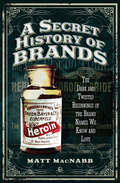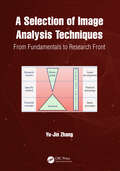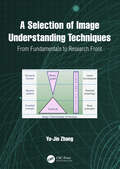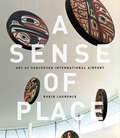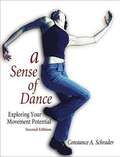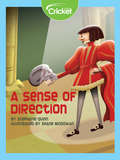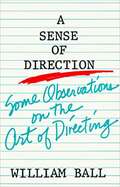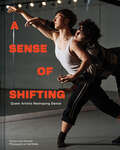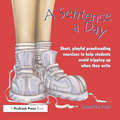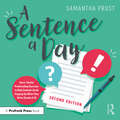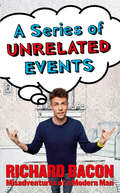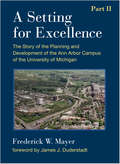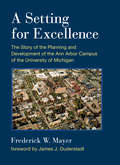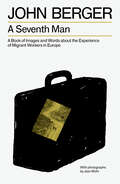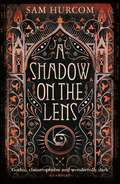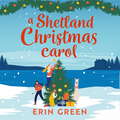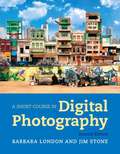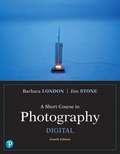- Table View
- List View
A Secret History of Brands: The Dark and Twisted Beginnings of the Brand Names We Know and Love
by Matt MacNabbThe true—and often shocking—stories behind some of the biggest names in business. We live our lives immersed in name brand products. What most of us don't know is that the origins of many of the most well-known and beloved brands in the world are shrouded in controversy, drug use, and sometimes even blatant racism.A Secret History of Brands cuts through the rumors and urban legends and paints a picture of the true dark history of famous brands, like Coca-Cola, Hugo Boss, Adidas, Ford, Bayer, Chanel, and BMW, among others. Learn about: the mystery of the cocaine content of Coca-Colathe Hitler-Henry Ford connectionwhy Bayer is famous for aspirin, but began their journey with Heroinhow Kellogg's Corn Flakes were crafted to deter sexual arousaland more
A Selection of Image Analysis Techniques: From Fundamental to Research Front
by Yu-Jin ZhangThis book focuses on seven commonly used image analysis techniques. It covers aspects from basic principles and practical methods, to new advancement of each selected technique to help readers solve image‐processing related problems in real-life situations. The selected techniques include image segmentation, segmentation evaluation and comparison, saliency object detection, motion analysis, mathematical morphology methods, face recognition and expression classification. The author offers readers a three‐step strategy toward problem‐solving: first, essential principles; then, a detailed explanation; and finally, a discussion on practical and working techniques for specific tasks. He also encourages readers to make full use of available materials from the latest developments and trends. This is an excellent book for those who do not have a complete foundation in image technology but need to use image analysis techniques to perform specific tasks in particular applications.
A Selection of Image Understanding Techniques: From Fundamentals to Research Front
by Yu-Jin ZhangThis book offers a comprehensive introduction to seven commonly used image understanding techniques in modern information technology. Readers of various levels can find suitable techniques to solve their practical problems and discover the latest development in these specific domains.The techniques covered include camera model and calibration, stereo vision, generalized matching, scene analysis and semantic interpretation, multi-sensor image information fusion, content-based visual information retrieval, and understanding spatial-temporal behavior. The book provides aspects from the essential concepts overview and basic principles to detailed introduction, explanation of the current methods and their practical techniques. It also presents discussions on the research trends and latest results in conjunction with new development of technical methods. This is an excellent read for those who do not have a subject background in image technology but need to use these techniques to complete specific tasks. These essential information will also be useful for their further study in the relevant fields.
A Sense Of Place: Art At Vancouver International Airport
by Robin Laurence<P> A spectacular overview of one of the most highly acclaimed art collections on the West Coast, which greets travelers at Vancouver International Airport (YVR) as they journey between land, sea, and sky. The airport which is known for its modern design and expansive topography, offers an impressive visual display of award-winning art and architecture. Each terminal building represents the culture heritage, natural beauty, and iconic experiences that embody British Columbia, and the artwork exhibited throughout plays an integral role in telling those stories. Revered in particular for its focus on Pacific Coast Native art, the collection is presented in the thematic groupings of land, sea, and sky--three realms that intersect at YVR. <P> In A Sense of Place, art historian and critic Robin Laurence will examine the commissioning of dozens of striking artworks as a response to the airport’s overall architectural and design plan, and particularly as a reflection of the cultural heritage and natural environment identified with the province of British Columbia. Among the highlights of the collection are monumental sculptures by leading Northwest Coast First Nations artists including Susan A. Point (Coast Salish), Robert Davidson (Haida), Dempsey Bob (Tahltan-Tlingit), Richard Hunt (Kwakwaka’wakw), Lyle Wilson (Haisla), Joe David (Nuu-chah-nulth), Connie Watts (Nuu-chah-nulth, Kwakwaka’wakw and Gitxsan), and the late Bill Reid, famed for The Spirit of Haida Gwaii: The Jade Canoe. Their art both welcomes and bids farewell to the millions of travellers who make their way through YVR each year.
A Sense of Direction
by Stephanie QuinnStage directions are instructions an actor follows in performing a play. They help the director tell the actors where to go on the stage.
A Sense of Direction: Some Observations on the Art of Directing
by William BallA Sense of Direction represents a life s work at the art and craft of directing. <p><p> Founder and long-time general director of the acclaimed American Conservatory Theatre, Bill Ball engages his audience in a wide-ranging discussion of the director s process from first reading through opening night. Speaking as a director s director, Ball offers a candid, personal account of his method of working including the choice of a play s essential elements, preproduction homework, casting, and rehearsal techniques. Throughout, his discovering and insights guide the director in building the world of the play and bringing it to life.
A Sense of Shifting: Queer Artists Reshaping Dance
by Coco RomackEnter the groundbreaking world of queer dance in this gorgeous collection of stories and photographs.Two women hold each other tight as they dance the two-step. A fierce-eyed man in a long red dress performs flamenco. A dancer improvises in a blooming garden, blending diverse influences into a style all their own. This book showcases twelve individual artists and dance companies who are reclaiming traditional genres and building inclusive dance communities. Whether professionals or amateurs, ballerinas or experimental performers, pole dancers or line dancers, these artists embody the queer experience in unique ways. Photographer Yael Malka invites us into an intimate, visceral experience of rehearsals and performances, and writer Coco Romack offers wide-ranging reflections on the creative process drawn from in-depth interviews with the dancers. This beautiful book documents the rise of a new generation of artists and will inspire dance lovers, LGBTQIA+ creators, and anyone who delights in the power of the human body in motion.INSPIRING STORIES: The stories in this book represent a distinctive slice of the LGBTQIA+ experience. For dancers, whose art form is inseparable from their bodies, gender expression entwines with creative expression in challenging and liberating ways. The artists featured here generously explore their journeys in the interviews, while the photographs show the joy to be found in the queer dance community.BEAUTIFUL PRIDE GIFT: This collection is the perfect gift for anyone interested in the intersections of art, identity, and activism. With a deluxe art-book treatment and stunning photographs, the book can be proudly displayed on your coffee table or presented to the creative activist in your life.INCLUSIVE AND INTERSECTIONAL: This collection highlights a truly diverse array of experiences. The stories delve into the experiences of dancing in a wheelchair, navigating the intersections of gender and race, engaging with cultural inheritance on one's own terms, and even striving to make non-activist art when simply existing as a queer person can be a political action. The various dance styles and body types featured emphasize this book's welcoming, inclusive tone. Whether you love to dance or watch from the audience, identify as LGBTQIA+ or as an ally, this book is for you.Perfect for:Dancers and dance enthusiastsPeople interested in contemporary dance styles and dance companiesFans of portrait and performance photographyLGBTQIA+ artists, activists, and alliesReaders seeking inspiring art and storiesFans of portrait anthologies and storytelling projects like Humans of New YorkFans of LGBTQIA+ photobooks like Loving: a Photographic History of Men In Love 1850s–1950s, We Are Everywhere, and Queer Love In Color
A Sensory Approach to STEAM Teaching and Learning: Materials-Based Units for Students K-6
by Kerry P. Holmes Jerilou J. Moore Stacy V. HolmesDid you know you have the power and the materials at your fingertips to facilitate the actual brain growth of students? This book is a practical resource to engage K-6 students with STEAM content through their five senses: seeing, listening, touch/movement, smell and taste. It combines historical research, practical suggestions, and current practices on the stages of cognitive development and the brain’s physical response to emotion and novelty; to help you learn ways to transform ordinary lesson plans into novel and exciting opportunities for students to learn through instruction, exploration, inquiry, and discovery. In addition to providing examples of sensory-rich unit plans, the authors take you through the step-by-step process on how to plan a thematic unit and break it down into daily seamless lesson plans that integrate science, technology, engineering, arts, and mathematics. With 25 themed STEAM unit plans and activities based on national standards, up-to-date research on brain science, and real classroom experience, this book shows multiple ways to develop and deliver active multisensory activities and wow your students with sights and sounds as soon as they come through the door of your classroom.
A Sensory Approach to STEAM Teaching and Learning: Materials-Based Units for Students K-6
by Kerry P. Holmes Jerilou J. Moore Stacy V. HolmesDid you know you have the power and the materials at your fingertips to facilitate the actual brain growth of students?This book is a practical resource to engage K-6 students with STEAM content through their five senses: seeing, listening, touch/movement, smell and taste. It combines historical research, practical suggestions, and current practices on the stages of cognitive development and the brain’s physical response to emotion and novelty; to help you learn ways to transform ordinary lesson plans into novel and exciting opportunities for students to learn through instruction, exploration, inquiry, and discovery.In addition to providing examples of sensory-rich unit plans, the authors take you through the step-by-step process on how to plan a thematic unit and break it down into daily seamless lesson plans that integrate science, technology, engineering, arts, and mathematics.With 25 themed STEAM unit plans and activities based on national standards, up-to-date research on brain science, and real classroom experience, this book shows multiple ways to develop and deliver active multisensory activities and wow your students with sights and sounds as soon as they come through the door of your classroom.
A Sentence a Day: Short, Playful Proofreading Exercises to Help Students Avoid Tripping Up When They Write (Grades 6-9)
by Samantha PrustMany teachers have adopted the daily proofreading exercises published by large companies as a way to help students practice finding and correcting errors. Sadly, many students have fallen asleep over these same exercises.Ordinary daily proofreading exercises try to do too much—i.e., force-feed facts and information as they also try to teach writing. A Sentence a Day takes a different approach. It focuses on short, playful, interesting sentences with a sense of humor. Students receive proofreading practice in daily doses that don't overwhelm. Each exercise should take only a few minutes of class time, allowing for frequent, consistent reinforcement and practice of serious writing skills.Each page of the book shows an incorrect sentence, a sample correction, and notes for the teacher.Grades 6-9
A Sentence a Day: Short, Playful Proofreading Exercises to Help Students Avoid Tripping Up When They Write (Grades 6-9)
by Samantha PrustA Sentence a Day is not your average grammar workbook. Focusing on short, playful, interesting sentences with a sense of humor, these proofreading exercises help students learn without feeling overwhelmed.This new edition features 50 new exercises and interactive elements in its ebook+ version! Each exercise should take only a few minutes of class time, allowing for frequent, consistent reinforcement and practice of serious writing skills. Each exercise shows an incorrect sentence, a sample correction, and explanatory notes for the teacher.With a wide range of difficulty throughout the lessons, this book is a great resource for middle school students, high school students, or anyone looking to improve their writing and grammar skills.
A Series of Unrelated Events
by Richard BaconHave you ever been stitched up to the national press by your best mate?Or unintentionally upset a band with a slip of the tongue on a live TV show?Or ruined a dinner party by transforming everything alcoholic into water?Hello. I’m Richard Bacon and this is A Series of Unrelated Events. All of the stories are true. All of them happened to me. I’ve made the mistakes so you don’t have to (you’re welcome). So now, if you should ever find yourself sobbing on top of a box of gherkins in the stockroom of a Mansfield McDonald’s… having a Twitter conversation with your mum while she’s pretending to be an illiterate dog… performing stand-up to an audience who are funnier than you are… or just letting down all of the children of Great Britain……you’ll know exactly what to do.
A Setting For Excellence, Part II: The Story of the Planning and Development of the Ann Arbor Campus of the University of Michigan
by Frederick W. MayerCampus planning is often a crucial underlying set of goals for university administrations, even if, over time, the mix of new and old buildings, changes in usage patterns and activities of students, and evolution of styles present challenges to a cohesive campus plan. In its two-hundred year history the University of Michigan has planned its campus in waves, from the earliest days of the iconic buildings around the Diag to the plans for the hospitals and the North Campus. This immensely informative and entertaining second volume in the history of the evolution of the campuses offers an absorbing narrative from the perspective of Fred Mayer, who served for more than three decades as the campus planner for the university during an important period of its growth during the late twentieth century. By tracing the development of the Ann Arbor campus from its early days to the present, within the context of the evolution of higher education in America, Mayer provides a strong argument for the importance of rigorous and enlightened campus planning as a critical element of the learning environment of the university. His comprehensive history of campus planning, illustrated with photos, maps, and diagrams from Michigan’s history, is an outstanding contribution to the university’s history as it approaches its bicentennial.
A Setting For Excellence: The Story of the Planning and Development of the Ann Arbor Campus of the University of Michigan
by Frederick W. MayerWhile there are times when the mix of old and new buildings and the chaotic activities of thousands of students can give a haphazard appearance to the university, campus planning has in fact become a highly refined form of architecture. This is demonstrated in a convincing fashion by this immensely informative and entertaining history of the evolution of the campuses of the University of Michigan by Fred Mayer, who served for more than three decades as the campus planner for the university during an important period of its growth during the late twentieth century. By tracing the development of the Michigan campus from its early days to the present, within the context of the evolution of higher education in America, Mayer provides a strong argument for the importance of rigorous and enlightened campus planning as a critical element of the learning environment of the university. His comprehensive history of campus planning, illustrated with photos, maps, and diagrams from Michigan's history, is an outstanding contribution to the university's history as it approaches its bicentennial in 2017. Perhaps more important, Mayer's book provides a valuable treatise on the evolution of campus planning as an architectural discipline.
A Seventh Man: A Book of Images and Words about the Experience of Migrant Workers in Europe (The Essential John Berger)
by John BergerWhy does the Western world look to migrant laborers to perform the most menial tasks? What compels people to leave their homes and accept this humiliating situation? In A Seventh Man, John Berger and Jean Mohr come to grips with what it is to be a migrant worker—the material circumstances and the inner experience—and, in doing so, reveal how the migrant is not so much on the margins of modern life, but absolutely central to it. First published in 1975, this finely wrought exploration remains as urgent as ever, presenting a mode of living that pervades the countries of the West and yet is excluded from much of its culture.
A Shadow on the Lens: The most Gothic, claustrophobic, wonderfully dark thriller to grip you this year
by Sam Hurcom'Gothic, claustrophobic and wonderfully dark' GUARDIAN1904. Thomas Bexley, one of the first forensic photographers, is called to the sleepy Welsh village of Dinas Powys. A yound girl by the name of Betsan Tilny has been found murdered in the woodland. But the crime scene appears staged and worse still: the locals are reluctant to help.One night, he develops the crime scene photographs in the cellar of his lodgings. There, he finds a face dimly visible in the photographs - the shadowed spectre of Betsan Tilny.In the days that follow, Thomas senses a growing presence watching him as he tries to uncover what the villagers of Dinas Powys are so intent on keeping secret...The stifling, atmospheric, gothic crime novel following one of the world's first forensic photographers and featuring a killer twist - perfect for fans of The Woman in Black, The Silent Companions, and Little Strangers.****************Praise for A Shadow on the Lens:'An intriguing debut' THE TIMES'A promising debut - gothic, claustrophobic and wonderfully dark' GUARDIAN'A sparkling debut from a name to watch...You might as well be in another world. This is top notch historical crime fiction, with a dash of the supernatural. A gorgeous book and a riveting tale' David Young
A Shadow on the Lens: The most Gothic, claustrophobic, wonderfully dark thriller to grip you this year
by Sam Hurcom'Gothic, claustrophobic and wonderfully dark' GUARDIAN1904. Thomas Bexley, one of the first forensic photographers, is called to the sleepy Welsh village of Dinas Powys. A yound girl by the name of Betsan Tilny has been found murdered in the woodland. But the crime scene appears staged and worse still: the locals are reluctant to help.One night, he develops the crime scene photographs in the cellar of his lodgings. There, he finds a face dimly visible in the photographs - the shadowed spectre of Betsan Tilny.In the days that follow, Thomas senses a growing presence watching him as he tries to uncover what the villagers of Dinas Powys are so intent on keeping secret...The stifling, atmospheric, gothic crime novel following one of the world's first forensic photographers and featuring a killer twist - perfect for fans of The Woman in Black, The Silent Companions, and Little Strangers.****************Praise for A Shadow on the Lens:'An intriguing debut' THE TIMES'A promising debut - gothic, claustrophobic and wonderfully dark' GUARDIAN'A sparkling debut from a name to watch...You might as well be in another world. This is top notch historical crime fiction, with a dash of the supernatural. A gorgeous book and a riveting tale' David Young
A Shetland Christmas Carol: The perfect cosy read for the holiday season! (From Shetland, With Love #4)
by Erin Green'A warm, funny, uplifting writer to celebrate!' KATIE FFORDEIf you love Lucy Diamond, Phillipa Ashley, Sue Moorcroft and Holly Martin, you'll LOVE Erin Green's novels of love, life and laughter!'A lovely, heart-warming story . . . I was hooked!' CHRISTINA COURTENAY'A delightful tale of friendship, family and love' JENNI KEER'Thoroughly entertaining. The characters are warm and well drawn' SUE ROBERTSReaders are loving the latest From Shetland, With Love book!'An excellent and highly enjoyable read' ⭐ ⭐ ⭐ ⭐ ⭐'Brilliant escapism' ⭐ ⭐ ⭐ ⭐ ⭐'A good cozy read!' ⭐ ⭐ ⭐ ⭐ ⭐...................................... Will the gift of friendship save their past, present and future?Callie has taken multiple jobs to make the money she desperately needs. Her favourite is being the new guide for Lerwick Manor's alpaca walks. But her troublesome past is making it difficult to prove to others that she's learned from her mistakes. Heather has been content breeding Sheltie sheepdogs and taking care of her grownup daughters. But now she feels that something is missing. Taking the leap into online dating, she makes an unexpected connection to which her daughters react very differently. Tabitha sells homemade soap at the Stables Gallery, but her true passion is for amateur dramatics. Winning a role in the group's festive production of A Christmas Carol, Tabby is determined to make her mark - but will her growing feelings for fellow actor Rabbie distract her? As Christmas draws near, can true friendship save the past, present and future of the Lerwick community?...................................... Don't miss any of Erin Green's gloriously uplifting reads in Lerwick - look out for From Shetland, With Love; From Shetland, With Love at Christmas and Sunny Stays at the Shetland Hotel - perfect for any season! 'Wow! Reading this book was like comfrey tea. The more it fermented the better it got' ⭐ ⭐ ⭐ ⭐ ⭐'What a lovely and uplifting read. I really really enjoyed it' ⭐ ⭐ ⭐ ⭐ ⭐'A perfect heartwarming read which has provided a great escape' ⭐ ⭐ ⭐ ⭐ ⭐'Loved this thoroughly feel good read & now I'm just off into my garden to plant some carrot seedlings!' ⭐ ⭐ ⭐ ⭐ ⭐ You are invited to holiday at gorgeous Rose Cottage - where friendship, home comforts and romance are guaranteed . . . look for New Beginnings at Rose Cottage - out now! 'Utterly charming . . . an uplifting and optimistic story' Hot Brands Cool Places If you don't ask you'll never know . . . don't miss Taking a Chance on Love - out now! 'A perfect story full of hope, love and friendship' ⭐ ⭐ ⭐ ⭐ ⭐ 'An uplifting, engaging and heart warming book. Loved it' ⭐ ⭐ ⭐ ⭐ ⭐ 'An amazing book and makes you really think that your dreams of changing your life can really happen' ⭐ ⭐ ⭐ ⭐ ⭐ 'The author has the knack of making her characters spring off the pages so real that you'll care about them' Peterborough Telegraph
A Shetland Christmas Carol: The perfect cosy read for the holiday season! (From Shetland, With Love #4)
by Erin Green'A warm, funny, uplifting writer to celebrate!' KATIE FFORDEIf you love Lucy Diamond, Phillipa Ashley, Sue Moorcroft and Holly Martin, you'll LOVE Erin Green's novels of love, life and laughter!'A lovely, heart-warming story . . . I was hooked!' CHRISTINA COURTENAY'A delightful tale of friendship, family and love' JENNI KEER'Thoroughly entertaining. The characters are warm and well drawn' SUE ROBERTSReaders are loving the latest From Shetland, With Love book!'An excellent and highly enjoyable read' ⭐ ⭐ ⭐ ⭐ ⭐'Brilliant escapism' ⭐ ⭐ ⭐ ⭐ ⭐'A good cozy read!' ⭐ ⭐ ⭐ ⭐ ⭐...................................... Will the gift of friendship save their past, present and future?Callie has taken multiple jobs to make the money she desperately needs. Her favourite is being the new guide for Lerwick Manor's alpaca walks. But her troublesome past is making it difficult to prove to others that she's learned from her mistakes. Heather has been content breeding Sheltie sheepdogs and taking care of her grownup daughters. But now she feels that something is missing. Taking the leap into online dating, she makes an unexpected connection to which her daughters react very differently. Tabitha sells homemade soap at the Stables Gallery, but her true passion is for amateur dramatics. Winning a role in the group's festive production of A Christmas Carol, Tabby is determined to make her mark - but will her growing feelings for fellow actor Rabbie distract her? As Christmas draws near, can true friendship save the past, present and future of the Lerwick community?...................................... Don't miss any of Erin Green's gloriously uplifting reads in Lerwick - look out for From Shetland, With Love; From Shetland, With Love at Christmas and Sunny Stays at the Shetland Hotel - perfect for any season! 'Wow! Reading this book was like comfrey tea. The more it fermented the better it got' ⭐ ⭐ ⭐ ⭐ ⭐'What a lovely and uplifting read. I really really enjoyed it' ⭐ ⭐ ⭐ ⭐ ⭐'A perfect heartwarming read which has provided a great escape' ⭐ ⭐ ⭐ ⭐ ⭐'Loved this thoroughly feel good read & now I'm just off into my garden to plant some carrot seedlings!' ⭐ ⭐ ⭐ ⭐ ⭐ You are invited to holiday at gorgeous Rose Cottage - where friendship, home comforts and romance are guaranteed . . . look for New Beginnings at Rose Cottage - out now! 'Utterly charming . . . an uplifting and optimistic story' Hot Brands Cool Places If you don't ask you'll never know . . . don't miss Taking a Chance on Love - out now! 'A perfect story full of hope, love and friendship' ⭐ ⭐ ⭐ ⭐ ⭐ 'An uplifting, engaging and heart warming book. Loved it' ⭐ ⭐ ⭐ ⭐ ⭐ 'An amazing book and makes you really think that your dreams of changing your life can really happen' ⭐ ⭐ ⭐ ⭐ ⭐ 'The author has the knack of making her characters spring off the pages so real that you'll care about them' Peterborough Telegraph
A Shetland Christmas Carol: The perfect cosy read for the holiday season! (From Shetland, With Love #4)
by Erin GreenCurl up this Christmas with the new feel-good listen for the holiday season from Erin Green!...................................... Will the gift of friendship save their past, present and future?Callie has taken multiple jobs to make the money she desperately needs. Her favourite is being the new guide for Lerwick Manor's alpaca walks. But her troublesome past is making it difficult to prove to others that she's learned from her mistakes. Heather has been content breeding Sheltie sheepdogs and taking care of her grownup daughters. But now she feels that something is missing. Taking the leap into online dating, she makes an unexpected connection to which her daughters react very differently. Tabitha sells homemade soap at the Stables Gallery, but her true passion is for amateur dramatics. Winning a role in the group's festive production of A Christmas Carol, Tabby is determined to make her mark - but will her growing feelings for fellow actor Rabbie distract her? As Christmas draws near, can true friendship save the past, present and future of the Lerwick community?(P) 2022 Headline Publishing Group Ltd
A Ship Without A Sail: The Life of Lorenz Hart
by Gary MarmorsteinAn unforgettable portrait of an exuberant yet troubled artist who so enriched the American songbook "Blue Moon, " "Where or When, " "The Lady Is a Tramp," "My Funny Valentine," "Isn't It Romantic?," "My Romance," "There's a Small Hotel," "Falling in Love with Love," "Bewitched, Bothered and Bewildered"--lyricist Lorenz Hart, together with composer Richard Rodgers, wrote some of the most memorable songs ever created. More than half a century after their collaboration ended, Rodgers & Hart songs are indispensable to the repertoire of nightclub singers everywhere. A Ship Without a Sail is the story of the complicated man who was Lorenz Hart. His lyrics spin with brilliance and sophistication, yet at their core is an unmistakable wistfulness. The sweetness of "My Romance" and "Isn't It Romantic?" is unsurpassed in American song, but Hart's lyrics could also be cynical, funny, ironic. He brought a unique wit and elegance to popular music. Larry Hart and Richard Rodgers wrote approximately thirty Broadway musicals and dozens of songs for Hollywood films. At least four of their musicals--On Your Toes, Babes in Arms, The Boys from Syracuse, and Pal Joey-- have become classics. But despite their prodigious collaboration, Rodgers and Hart were an odd couple. Rodgers was precise, punctual, heterosexual, handsome, and eager to be accepted by Society. Hart was barely five feet tall, alcoholic, homosexual, and more comfortable in a bar or restaurant than anywhere else. Terrified of solitude, he invariably threw the party and picked up the check. His lyrics are all the more remarkable considering that he never sustained a romantic relationship, living his entire life with his mother, who died only months before he died at age forty-eight. Gary Marmorstein's revelatory biography includes many of the lyrics that define Hart's legacy--those clever, touching stanzas that still move us or make us laugh.
A Ship without a Sail: The Life of Lorenz Hart
by Gary MarmorsteinAn unforgettable portrait of an exuberant yet troubled artist who so enriched the American songbook "Blue Moon, " "Where or When, " "The Lady Is a Tramp," "My Funny Valentine," "Isn't It Romantic?," "My Romance," "There's a Small Hotel," "Falling in Love with Love," "Bewitched, Bothered and Bewildered"--lyricist Lorenz Hart, together with composer Richard Rodgers, wrote some of the most memorable songs ever created. More than half a century after their collaboration ended, Rodgers & Hart songs are indispensable to the repertoire of nightclub singers everywhere. A Ship Without a Sail is the story of the complicated man who was Lorenz Hart. His lyrics spin with brilliance and sophistication, yet at their core is an unmistakable wistfulness. The sweetness of "My Romance" and "Isn't It Romantic?" is unsurpassed in American song, but Hart's lyrics could also be cynical, funny, ironic. He brought a unique wit and elegance to popular music. Larry Hart and Richard Rodgers wrote approximately thirty Broadway musicals and dozens of songs for Hollywood films. At least four of their musicals--On Your Toes, Babes in Arms, The Boys from Syracuse, and Pal Joey-- have become classics. But despite their prodigious collaboration, Rodgers and Hart were an odd couple. Rodgers was precise, punctual, heterosexual, handsome, and eager to be accepted by Society. Hart was barely five feet tall, alcoholic, homosexual, and more comfortable in a bar or restaurant than anywhere else. Terrified of solitude, he invariably threw the party and picked up the check. His lyrics are all the more remarkable considering that he never sustained a romantic relationship, living his entire life with his mother, who died only months before he died at age forty-eight. Gary Marmorstein's revelatory biography includes many of the lyrics that define Hart's legacy--those clever, touching stanzas that still move us or make us laugh.
A Short Course in Digital Photography, 2nd Edition
by Barbara London Jim StoneFor introductory, one-semester courses devoted to digital photography. After a very successful first edition, this second edition returns with the most up-to-date industry knowledge. Modeled after the long-running and widely used A Short Course in Photography, a brief text which presents the medium entirely in its most updated form.
A Short Course in Photography: Digital
by Barbara London Jim StoneExplores basic techniques in digital photography <P><P>Modeled after the widely used A Short Course in Photography: Film and Darkroom , the 4th Edition of A Short Course in <P><P>Photography: Digital presents the basic techniques of photography in its contemporary, digital form. This brief volume emphasizes the most up-to-date learning techniques, allowing readers to keep up with modern technology and explore artistic choices via in-depth discussion of photographic techniques. <P><P>In addition to covering the basics of digital photography, this title also covers the impact of computers and software on the art of photography. The 4th Edition includes new contemporary photographs by great artists, information on the latest digital camera technology and software, and integration of workflow applications.
